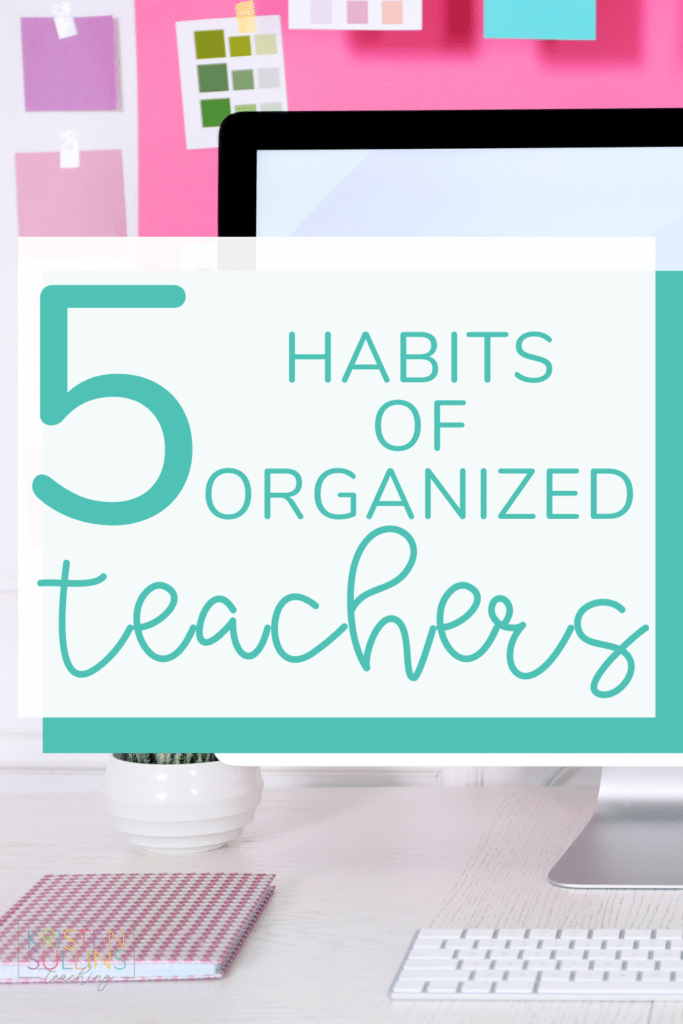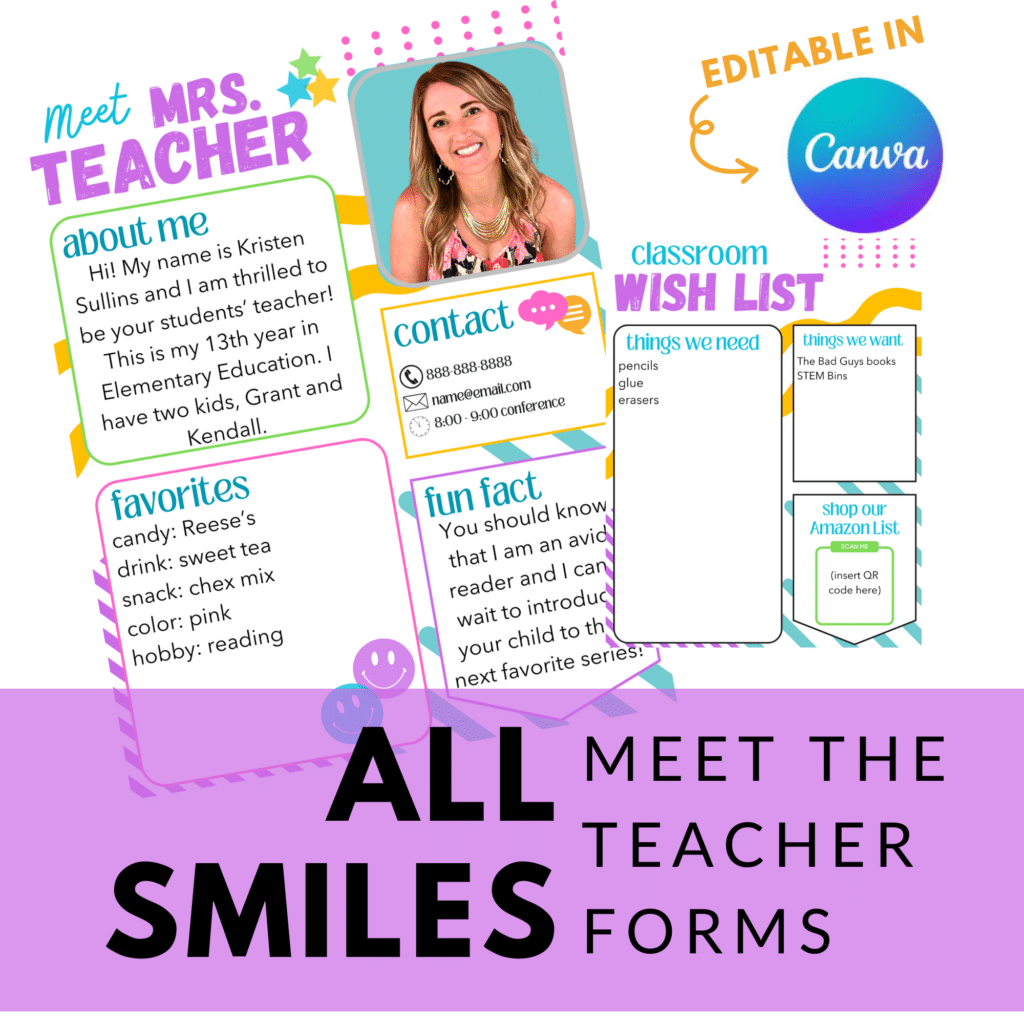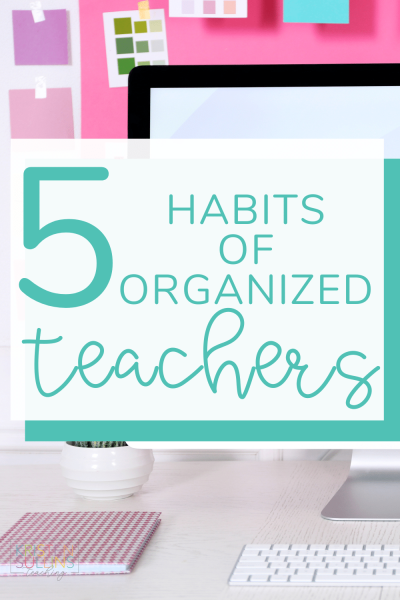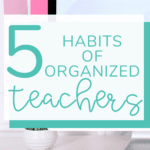I think we all dream of being an organized teacher, but we often lack the habits or motivation to be an organized teacher consistently. The problem (as we know) is that no two days in an Elementary school ever look the same. Once you get really good at something, you get thrown a curveball in the form of a class party, testing season or even a new student added to your class. So, how do those “dream teachers” always manage to stay on top of things and look so organized while doing it? One word: HABITS.
If you are a fan of productivity (or maybe you want to be), I highly suggest reading Atomic Habits by James Clear. I truly believe that building effective habits in your life at home and at work are the key to efficiency.
The book provides very detailed, scientific explanations. But, if you want it put simply, follow these steps:
- Identify what you already do
- Choose one new habit that you want to try
- “Stack” those two tasks together
For example, if you want to be better at positive phone calls home, and you already check your email everyday once students leave the classroom, then use your email as a trigger (reminder) to make a quick positive phone call home!

Habit 1: Master Your To - Do List
Step one to becoming an organized teacher, for some of you, will be to actually make a to do list. And I know some of you are even thinking “I don’t need a to-do list, it’s a waste of time”. However, keeping a to-do list can also contribute to reducing stress and anxiety levels. When tasks are written down, they are less likely to be forgotten or overlooked, which alleviates the mental burden of trying to remember everything.
Additionally, crossing off completed tasks provides a sense of accomplishment and satisfaction, boosting your motivation and confidence. This positive reinforcement cycle can help you maintain momentum and stay motivated throughout the day.
Here are a few tips for mastering your to-do lis like an organized teachert:
Prioritize tasks: Start by listing all tasks, then prioritize them based on urgency and importance. Use techniques like Eisenhower Matrix (urgent vs. important) or ABC prioritization (A tasks are most important).
Break tasks into smaller steps: Large tasks can be overwhelming. Break them down into smaller, actionable steps to make them more manageable and less daunting.
Set deadlines: Assign realistic deadlines to each task. This helps create a sense of urgency and prevents procrastination.
Batch similar tasks: Group similar tasks together (e.g., phone calls, emails) to streamline your workflow and save time.
Use time-blocking: Allocate specific blocks of time for different tasks or categories of tasks. This helps in managing your time effectively and ensures tasks get done.
Practice the two-minute rule: If a task takes less than two minutes to complete, do it immediately rather than adding it to your list.
Habit 2: Set a Goal and Review It Daily
Organized teachers rarely seem overwhelmed and there’s a good reason for it… they aren’t trying to do ALL the things. As teachers, our greatest downfall is that we are lifetime learners which means we are ALWAYS trying to get better at EVERYTHING.
Choose ONE area of growth. Set a simple, measurable goal for yourself of how you want to grow in that area and how you will track your progress.
Make a habit of reviewing your goal every single day. Set a timer on your phone or set up a calendar reminder to review your goal every single day.
I know you are probably thinking “I don’t have time for that”, but what you are really making time for is celebration. As teachers we rarely allow ourselves to celebrate our wins because we are usually too busy moving on to the next goal.
Have you ever heard of the snowball effect? I usually hear it referenced when talking about debt payoff, but the same method is also true for to do lists and motivation. When you mark one thing off your to-do list, or reach a small foothold in your climb towards a big goal, you are ultimately building momentum to conquer the rest of your to-do list or finishing the final climb of that huge goal you have been tackling!
Habit 3: Create Organized Teacher Systems
I consider myself one of those “organized teachers” and one of the catch phrases that my teacher friends often make fun of me for is “Ooh, I have a system for that!”.
What is a system? A system is any structured and systematic approach or framework used to manage and streamline processes, resources, information, and tasks. To put it simply, it’s how you do the things you do AND how you do those things consistently every time. Systems can take some time to think through and establish, BUT once established, they allow you to make decisions quickly and efficiently (which as an organized teacher is a MUST).
Here are some key organizational systems that teachers often find essential:
- Lesson Planning and Curriculum Organization: Teachers need a system to plan and organize their lessons effectively. This includes templates or software for creating lesson plans, curriculum maps, and unit plans. Digital tools like Google Classroom, Microsoft OneNote, or dedicated educational platforms can be used for storing and sharing lesson materials.
- Classroom Management Tools: Classroom management systems help teachers maintain discipline, track student behavior, and communicate expectations clearly. Tools like ClassDojo, Seesaw, or even simple behavior charts can aid in managing student conduct and engagement.
- Student Assessment and Data Management: Teachers require systems to assess student learning and manage assessment data efficiently. This may involve gradebooks (digital or physical), assessment tools, and spreadsheets for tracking student progress.
- Professional Development Tracking: Teachers need a way to track their professional development activities, including workshops, seminars, certifications, and ongoing training.
- Communication and Collaboration Platforms: Effective communication with students, parents, and colleagues is crucial. Teachers can use platforms like Remind for messaging parents and students,
- Classroom Library and Resource Management: Organizing classroom libraries and instructional resources is essential for easy access during lessons. Systems like library cataloging software (e.g., LibraryThing, Booksource) or digital bookshelf apps can help in managing and categorizing books and educational materials.
- Time Management and Planning Tools: Teachers benefit from tools that help manage their time efficiently, including calendars (Google Calendar, Outlook), task management apps (Todoist, Trello), and time-blocking techniques for planning lessons, grading, and other tasks.
Effective organizational systems not only streamline daily tasks but also enhance productivity, communication, and professional growth for teachers. Choosing and implementing the right tools based on individual preferences and school requirements can significantly support effective teaching and learning environments.
Habit 4: Finish Your Current Activity
This habit of an organized teacher is perhaps the easiest, yet hardest to follow. I want you to imagine a transaction with a bank teller. Before a bank teller moves on to the next customer, they take the time to put away the ENTIRE transaction before starting a new one. Obviously this strategy is required for a bank teller to make sure money doesn’t get mixed up and that transactions stay confidential. BUT it’s also a great habit for teachers who want to stay organized.
As teachers, I think we are sometimes the worst at letting our desks get cluttered with all the things, because to put it plainly, we just don’t have time in the moment to put things away. BUT, if you can make a habit of “finishing your current activity” before starting a new one, you will find yourself SO MUCH more organized.
Here’s a tip: make a habit of putting things away during transitions
- When students are lining up
- When students are putting away papers/materials
- At the end of your conference before students come back
- Before your lunch break/recess break
- As students are packing up to go home
Habit 5: Make a Plan for Tomorrow
Organized teachers plan ahead (literally). Leave yourself a sticky note of 1-3 things that are top priority for tomorrow! That way your must-do tasks will be top of mind as soon as you walk through your classroom door tomorrow morning.
My motto is “If you can plan for it, you can prepare for it (or even prevent it).”
You can also effectively plan your day in advance by blocking off time for any major projects that you know are going to take major brain energy or focus.
A word of caution, sometimes I get ambitious and try to plan out my entire week this way. And sometimes it works. But more times than not, too many things pop up and my “top 3 priorities” change from day to day. Now, I do make a “skeleton outline” of what I want to do that week, but I don’t choose my top 3 until the day before or the morning of!












